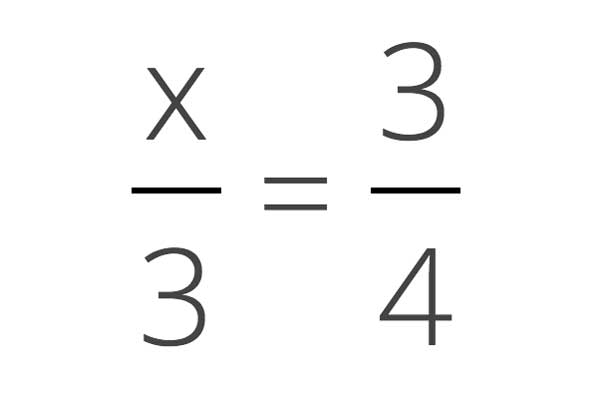Solve For Unknown Fraction Calculator
Use our cross-multiplication calculator to find an unknown numerator or denominator in a fraction. Leave one field blank and the calculator will solve that field.
Solution:
Steps to Solve the Missing Value
On this page:
How to Solve Fractions in Algebraic Equations
You can solve for an unknown value x in algebraic equations containing fractions using a few simple steps.

Step One: Cross Multiply the Fraction
The first step to solving for the unknown numerator or denominator in a fraction is to cross-multiply the numerators and denominators. To cross-multiply, multiply each numerator by the denominator in the opposite fraction.
This creates a new equation that is not a fraction and is easier to solve.
For example, cross-multiply the following equation to create a new equation without a fraction:
x / 3 = 3 / 4
(4 × x) = (3 × 3)
4x = 9
Step Two: Solve the Equation
The next step is to solve the resulting equation. To start, get x by itself by dividing both sides of the equation by the number in front of the x.
For example, let’s solve the equation 4x = 9.
4x = 9
4x / 4 = 9 / 4
x = 9 / 4
Step Three: Reduce the Fraction
The final step is to reduce the fraction. Start by finding the greatest common factor of the numerator and the denominator.
Then, divide both the numerator and denominator by the common factor. If you’re still not sure, check out our fraction simplifier to reduce your fraction.
If the numerator of the fraction is greater than 1 then you might want to turn the fraction into a mixed number. To do so, divide the numerator by the denominator.
The quotient will be the whole number, the remainder will be the numerator, and the original denominator will be the denominator.
For example, the fraction from the examples above cannot be simplified, but it can be turned into a mixed number.
9 / 4 = 9 ÷ 4
9 ÷ 4 = 2 R1
2 1 / 4
To find the missing value of a fraction, you can utilize multiples. For instance, consider the following equation: 1/2 = x/100.
To obtain the value of x, you need to multiply both the numerator and denominator by the same factor. In this case, you need to multiply the denominator 2 by 50 to get 100.
Since they are equivalent fractions, you also have to multiply the numerator 1 by 50 to maintain the equality. As a result, x is equal to 50.
You might also be interested in our fraction calculator for solving expressions with fractions.


